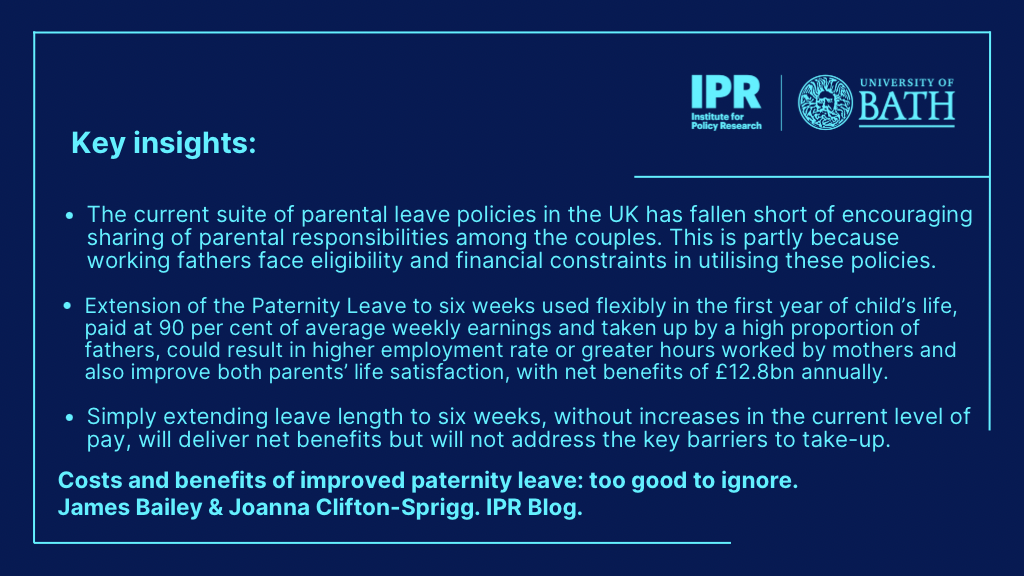The UK’s 2015 Shared Parental Leave (SPL) scheme aimed to reduce gender inequalities at home and at work. Shareable leave entitlements can substantially benefit those who use it – but, due to complex eligibility criteria and procedures, as well as poor levels of compensation, just 2% of eligible working parents in the UK have utilised this policy.
International evidence shows that fathers take well-paid leave earmarked specifically to them. High take-up can result in more gender-equal sharing of caring responsibilities among couples and, by extension, allow mothers to return to the labour market, benefitting the economy.
In our Cost-Benefit Analysis we evaluate a proposal to extend Paternity Leave to six weeks (used flexibly within the first year) with four possible pay scenarios – at 90 per cent of average weekly earnings (with and without a cap), at the National Living Wage, and at the already available Statutory Paternity Pay. We anticipate that three quarters of working fathers would use the highly paid leave (at 90 per cent of average weekly earnings), with substantial benefit to the UK economy and parental wellbeing. When paid at lower rates, this policy would be taken up by a much lower proportion of fathers.
Joanna Clifton-Sprigg is a Lecturer (Assistant Professor) in Economics at the Department of Economics at the University of Bath. My research interests are in labour and gender economics, migration and economics of education. James Bailey is a Final year Economics undergraduate, University of Bath where he has undertaken a placement year evaluating international Paternity Leave reforms. They are co-authors of the recent policy brief ‘Costs and benefits of improved paternity leave: too good to ignore’ - with Dr Alistair Hunt and Lily Zelezetskii, in partnership with The Fatherhood Institute and Working Families, which considers an overhaul of paternity leave.
Current UK Paternity Leave provision is two weeks paid at the statutory rate of just £187.18 per week. Eligible working parents can also share up to fifty weeks of leave in the child’s first year of life which, after the initial six weeks, is paid at the same rate as Paternity Leave. Fathers have demonstrated desire to take longer leave, but are limited by strict eligibility criteria, low levels of compensation and (in the case of SPL) complex procedures.
At the same time, women in the UK adjust their labour market behaviour after childbirth more than men, which explains to a large extent existing gender inequalities. The employment rate of women falls from above 90 per cent to below 75 per cent around childbirth, and employed mothers reduce their average weekly working hours from 40 to under 30. This is not the case for men.
The demonstrated benefits to greater paternity leave have led us to consider an improvement offering a day-one right to six weeks paid at 90 per cent of Average Weekly Earnings (AWE) – more aligned in terms of pay with the current Maternity Leave entitlement and (unlike SPL) not conditional on mother’s employment.
We model three key scenarios based on different take-up rates: a Central Estimate, our best guess of fathers’ take-up behaviour, and Low and High estimates. We chose these rates based on evidence from similar policy changes in other, comparable countries. The Central estimate is close to that of Spain, identified as a most comparable case (with similar policy shifts, fathers’ behaviour, and constraints to take-up).
Modelling results
Our model assesses the total cost of delivering six weeks at 90 per cent AWE (and used by three quarters of eligible working fathers) to the government and to businesses at £1.8 billion, through leave payments, forgone tax revenues, and administrative, reorganisation, and familiarisation costs. These costs are substantially outweighed by benefits from increased engagement of mothers in the labour market and wellbeing of both parents.
When fathers spend more time parenting, mothers return to work earlier or increase their working hours upon return, and are more likely to commit to working full-time. For mothers outside the labour market, evidence suggests we may see a 4.5 per cent increase in employment rate. Among already employed mothers we could expect a 4 per cent increase in hours worked. Fathers’ employment remains unaffected.
If realised, such a change in the labour market would go a long way towards the government’s targets of ‘Getting Britain Working’ and reducing gender inequalities at home and at work. To achieve this, some of the leave must be used sequentially by parents, encouraging fathers to help with childcare and facilitating mother’s increased employment.
Many potential benefits of such policies often remain unaccounted for, being difficult to attach a value to them. In our analysis we capture some of the wellbeing effects one may see from greater leave-use by both parents. Focusing on life satisfaction improvements and relying on commonly used WELLBYs, wellbeing-adjusted life years, we quantify the effect at £12.8 billion; together with £0.5 billion in labour market benefits, this vastly outweighs the policy’s £1.8 billion cost, at a 32x return-on-investment.
We leave various further benefits unquantified due to data or methodological limitations. For families, paternity leave brings positive developmental outcomes for children (generating important spillover effects like stronger familial bonds, greater couple stability, and increased fertility), long-term gains in early education outcomes and future earnings, reduced time and financial burden associated with job loss, and reduced gender-stereotypical attitudes. It does not impact either parent’s employment outcomes unless atypically long. For businesses, providing paternity pay signals a care for employee wellbeing, and improves staff retention – reducing costs from recruitment, training, and lost productivity. Lengthening statutory paternity leave should reduce the opportunity cost of taking such leave versus career advancement; increase the leave fathers feel able to take before returning to work; and improve employees’ perceptions of wellbeing benefits.
Alternative pay configurations
We consider imposing a £1,200 weekly cap on leave payments, which would likely affect the top 8 per cent of working fathers. Doing so would limit the costs but still yield £12.2 billion in net benefits.
We also consider offering payments at the National Living Wage, currently £12.21/hour or £457.88 for a 37.5-hour work week. This sees take-up reduced to roughly half of eligible fathers, reducing costs but also reducing net benefits to £4.4 billion.
Finally, we consider increasing the length of leave to six weeks but leaving payments at the currently available Statutory Paternity Pay rate. While this substantially reduces the costs of the policy, evidence suggests this would significantly limit take-up, with fathers constrained by financial considerations, especially at lower income levels. Therefore, at the central estimate (which now predicts take-up by 35 per cent of fathers), we predict £2.7 billion in net benefits – still substantial, but much less impactful than our recommended policy of pay at 90 per cent AWE.
Recommendations
- The government should review the current package of parental leave policies, with consideration being given to the financial compensation and the length of entitlement granted specifically for fathers.
- Six weeks of paternity leave (taken flexibly within the first year of child’s life) paid at 90 per cent of average weekly earnings and available to employee fathers as day-one right would be likely to be taken up by a significant proportion of fathers and lead to a net social benefit.
- The pay could be capped at £1,200 a week. The cap would affect the top 8 per cent of highest earning fathers and result in slightly lower net benefit.
- Many of the non-monetary benefits of this policy were excluded from analysis due to methodological and data challenges. They should be considered in future work. Therefore, what we provide is an underestimate of the gains to be made.
- Changes further than the proposed increases in paternity leave length and generosity would require a greater overhaul of the current system, to ensure alignment with maternity leave and shared parental leave entitlements.
- Six weeks of well-paid leave for fathers would constitute a desired and important first step in delivering change. It is pivotal to guaranteeing high take-up among fathers. However, transformative change requires carefully considered design to incentivise change within households and workplaces, resulting in greater gender equality. For instance, based on evidence from other countries the labour market benefits are judged to be most likely to materialise in case of sequential rather than simultaneous take-up of some of the leave by fathers. Moreover, other measures introduced alongside the policy would be welcome to reshape gender expectations around caregiving.
- We support continued provision of SPL but note that redesign is required to remove current barriers to take-up and to align it with the improved paternity leave.
To find out more, read the full policy brief here: Costs and benefits of improved paternity leave: too good to ignore - a new IPR policy brief by Dr Joanna Clifton-Sprigg, Dr Alistair Hunt, Lily Zelezetskii and James Bailey, in partnership with The Fatherhood Institute and Working Families, which considers an overhaul of paternity leave.
All articles posted on this blog give the views of the author(s), and not the position of the IPR, nor of the University of Bath.
Respond





